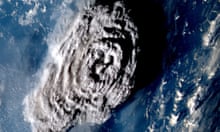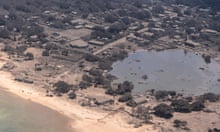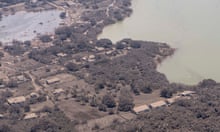Surveillance flights have been sent from Australia and New Zealand to assess damage after Tonga was isolated from the rest of the world following a volcanic eruption. Here’s how events have played out over the past few days.
14 January
About 4.20am local time (3.10pm GMT on 13 January), the Hunga Tonga-Hunga Ha’apai volcano erupts, sending plumes of ash, steam and gas up to 20km into the atmosphere.
The undersea volcano is located about 65km (40 miles) north of Tonga’s capital, Nuku’alofa, and is part of a vast arc of volcanoes and ocean trenches known as the Pacific “Ring of Fire”.
Though it only rises 114 metres above sea level, the Hunga Tonga-Hunga Ha’apai volcano overall is 1.8km high and 20km wide.
A public notice issued by the Tonga Geological Services notes continuous eruption and a 5km-wide plume. The volcano had been active since an earlier eruption on 20 December but was declared dormant by the authority on 11 January.
Volcanic activity in 2014 and 2015 had joined the islands of Hunga Tonga and Hunga Ha’apai, which were themselves produced by older volcanic eruptions. A satellite image taken after the eruption shows that the connecting volcanic cone has been largely destroyed.
The Tonga Meteorological Services issue a tsunami warning for all islands across the country, with waves of up to 30cm recorded following the eruption.
15 January – 5.10pm (4.10am GMT)
The Hunga Tonga-Hunga Ha’apai volcano erupts again at 5.10pm local time on Saturday 15 January.
The massive eruption, larger than the one on 14 January, generates an enormous amount of energy and creates an umbrella cloud of ash, spreading the plume concentrically outwards instead of being dispersed in one direction by wind.
The initial height of the ash plume is an estimated 15.2km in altitude, later rising up to 30km high. The plume spreads to 260km in diameter before being distorted by wind.
The strength of the eruption – as measured by the volcanic explosivity index – is still unknown, as it requires exact figures on how high the plume reaches and the volume of ash ejected.
Images from weather satellites, such as this animated video using imagery from a Korean weather satellite, show the dramatic explosion, with ash and water vapour covering an area hundreds of kilometres in diameter:
15 January – 5.30pm
Twenty minutes later, at 5.30pm local time, a 1.2 metre tsunami wave is observed at Nuku’alofa, Tonga’s capital, according to the Australian Bureau of Meteorology.
Photos and videos emerge on social media of large waves flooding coastal areas, with reports of people making their way inland and to higher ground. Footage shows waves causing damage to buildings and infrastructure such as seawalls.
15 January – 6.15pm
By evening in the Pacific, the volcano is raining ash and “tiny pebbles” on neighbouring Tongan islands, with reports of “darkness blanketing the sky”.
Nuku’alofa is reportedly covered in a thick film of volcanic dust. There are concerns about contamination of food and water supplies, as well as acid rain.
In addition to preventing aircraft from flying, ash hampers recovery efforts because it “buries gardens and impacts plants with consequences for food supply, and is likely to contaminate water supplies,” volcanologist Dr Chris Firth says.
This video of satellite images from the National Institute of Water and Atmospheric Research in New Zealand shows the plume of ash from the eruption enveloping the main island of Tonga, Tongatapu.
15 January – 7pm
An air pressure surge from the volcano’s eruption is recorded at seismic stations internationally, including in New Zealand, Australia, the US, and the UK, where two shockwaves are observed.
Our atmosphere acts as a fluid, like dropping a pebble in a still pond and seeing the ripples.
— Met Office (@metoffice) January 16, 2022
A UK pressure trace for the past 24 hours shows how our atmosphere continues to see those ripples since the first pressure wave from the #Tonga eruption arrived on Saturday evening. pic.twitter.com/rr0xBONe4v
Data from the Australian Bureau of Meteorology shows the shockwave travelled faster than 1000 km/h – almost as fast as the speed of sound – and resulted in a noticeable jump in atmospheric pressure.
Sonic booms from the eruption were heard across the Pacific, including in Fiji and Vanuatu, and as far as Alaska, more than 9,000km away.
Tonga Volcano eruption heard from Lakeba, Fiji 😢🇹🇴 #TongaVolcano pic.twitter.com/qc9ISL25QX
— Portia Dugu (@portiajessene) January 15, 2022
15 January – 8.15pm
In the hours that follow, tsunami warnings are issued across the Pacific, including in New Zealand, Australia, the west coast of the US, and Japan, where around 230,000 people across eight prefectures are ordered to evacuate.
Experts believe the tsunami activity could have been triggered either by shock waves propagating through water, or by a landslide on the undersea part of the volcano.
Only an estimated 5% of tsunamis have historically resulted from volcanoes, including the 1883 eruption of Krakatoa, which caused a devastating tsunami in the Indian Ocean. Krakatoa’s violent eruption was reported to have been heard 4,800km away.
16 January
Large waves and strong currents are recorded in many coastal areas globally.
Images on social media show destruction of coastal homes on several islands in the South Pacific, while Japan’s Pacific coast sees waves of nearly 1.2 metres. Authorities in New Zealand confirm that an undersea cable linking Tonga to Fiji has been damaged.
Two people drown off a beach in the Lambayeque region of Peru, after unusually high waves are recorded there. The country closes 22 ports as a precaution.
The Californian city of Santa Cruz is hit by a tidal surge, damaging boats and resulting in flooding.
17 January – 2pm
Australia and New Zealand send planes to Tonga to assess the damage to critical infrastructure such as roads, ports and powerlines. Surveillance flights had been delayed as a result of the ash cloud blanketing Tonga.
17 January – 3pm
A veil of ash from Saturday’s Hunga Tonga-Hunga Ha’apai volcano eruption is seen drifting west towards northern Australia, at an altitude between 12-20km, New Zealand’s meteorological service reports.









